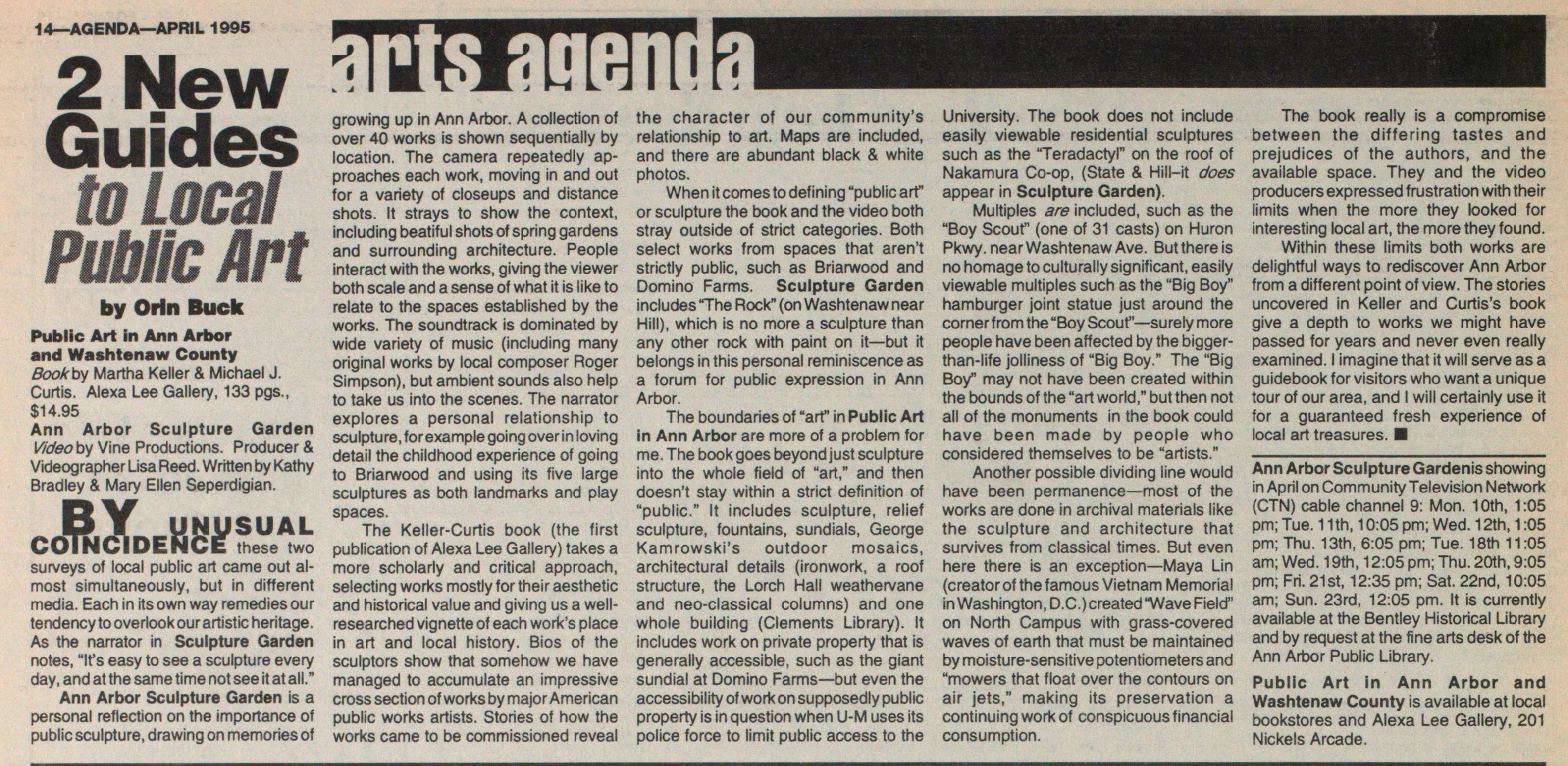2 New Guides To Local Public Art

Public Art in Ann Arbor and Washtenaw County Book by Martha Keiler & Michael J. Curtis. Alexa Lee Gallery, 133 pgs., $14.95
Ann Arbor Sculpture Garden Video by Vine Productions. Producer & Videographer Lisa Reed. Written by Kathy Bradley & Mary Ellen Seperdigian.
BY UNUSUAL COINCIDENCE these surveys of local public art carne out almost simultaneously, but in different media. Each in its own way remedies our tendency to overlook our artistic heritage. As the narrator in Sculpture Garden notes, "It's easy to see a sculpture every day , and at the same time not see it at all."
Ann Arbor Sculpture Garden is a personal reflection on the importance of public sculpture, drawing on memories of growing up in Ann Arbor. A collection of over 40 works s shown sequentially by location. The camera repeatedly approaches each work, moving in and out for a variety of closeups and distance shots. It strays to show the context, Including beautiful shots of spring gardens and surrounding architecture. People interact with the works, giving the viewer both scale and a sense of what it is like to relate to the spaces established by the works. The soundtrack is dominated by wide variety of music (including many original works by local composer Roger Simpson), but ambient sounds also help to take us into the scènes. The narrator explores a personal relationship to sculpture, for example going over in loving detail the childhood experience of going to Briarwood and using its five large sculptures as both landmarks and play spaces.
The Keller-Curtis book (the first publication of Alexa Lee Gallery) takes a more scholarly and critical approach, selecting works mostly for their aesthetic and historical value and giving us a well researched vignette of each work's place in art and local history. Bios of the sculptors show that somehow we have managed to accumulate an impressive cross section of works by major American public works artists. Stories of how the works came to be commissioned reveal the character of our community's relationship to art. Maps are included, and there are abundant black & white photos.
When it comes to defining "public art or sculpture the book and the video both stray outside of strict categories. Both select works from spaces that aren't strictly public, such as Briarwood and Domino Farms. Sculpture Garden includes The Rock" (on Washtenaw near Hill), which is no more a sculpture than any other rock with paint on it - but it belongs in this personal reminiscence as a forum for public expression in Ann Arbor.
The boundaries of "art" in Public Art In Ann Arbor are more of a problem for me. The book goes beyond just sculpture into the whole field of "art," and then doesn't stay within a strict definition of "public." It includes sculpture, relief sculpture, fountains, sundials, George Kamrowski's outdoor mosaics, architectural details (ironwork, a roof structure, the Lorch Hall weathervane and neo-classical columns) and one whole building (Clements Library). It includes work on private property that is generally accessible, such as the giant sundial at Domino Farms - but even the accessibility of work on supposedly public property is in question when U-M uses its police force to limit public access to the University. The book does not include easily viewable residential sculptures such as the "Teradactyl" on the roof of Nakamura Co-op, (State & Hill-it does appear in Sculpture Garden).
Multiples are included, such as the "Boy Scout" (one of 31 casts) on Huron Pkwy. near Washtenaw Ave. But there is no homage to culturally significant, easily viewable multiples such as the "Big Boy" hamburger joint statue just around the corner from the "Boy Scout"- surely more people have been affected by the bigger-than-life jolliness of "Big Boy." The "Big Boy" may not have been created within the bounds of the "art world," but then not all of the monuments in the book could have been made by people who considered themselves to be "artists."
Another possible dividing line would have been permanence- most of the works are done in archival materials like the sculpture and architecture that survives from classical times. But even here there is an exception- Maya Lin (creator of the famous Vietnam Memorial in Washington, D.C.) created "Wave Field" on North Campus with grass-covered waves of earth that must be maintained by moisture-sensitive potentiometers and "mowers that float over the contours on air jets," making its preservation a continuing work of conspicuous financial consumption.
The book really is a compromise between the differing tastes and prejudices of the authors, and the available space. They and the video producers expressed frustration with their limits when the more they looked for interesting local art, the more they found.
Within these limits both works are delightful ways to rediscover Ann Arbor from a different point of view. The stories uncovered in Keller and Curtis's book give a depth to works we might have passed for years and never even really examined. I imagine that it will serve as a guidebook for visitors who want a unique tour of our area, and I will certainly use it for a guaranteed fresh experience of local art treasures. ■
Ann Arbor Sculpture Garden is showing in April on Community Televisión Network (CTN) cable channel 9: Mon. 10th, 1:05 pm; Tue. 11 th, 10:05 pm; Wed. 12th, 1:05 pm; Thu. 13th, 6:05 pm; Tue. 18th 11:05 am; Wed. 19th, 12:05 pm; Thu. 20th, 9:05 pm; Fri. 21 st, 12:35 pm; Sat. 22nd, 10:05 am; Sun. 23rd, 12:05 pm. It is currently available at the Bentley Historical Library and by request at the fine arts desk of the Ann Arbor Public Library.
Public Art in Ann Arbor and Washtenaw County is available at local bookstores and Alexa Lee Gallery, 201 Nickels Arcade.